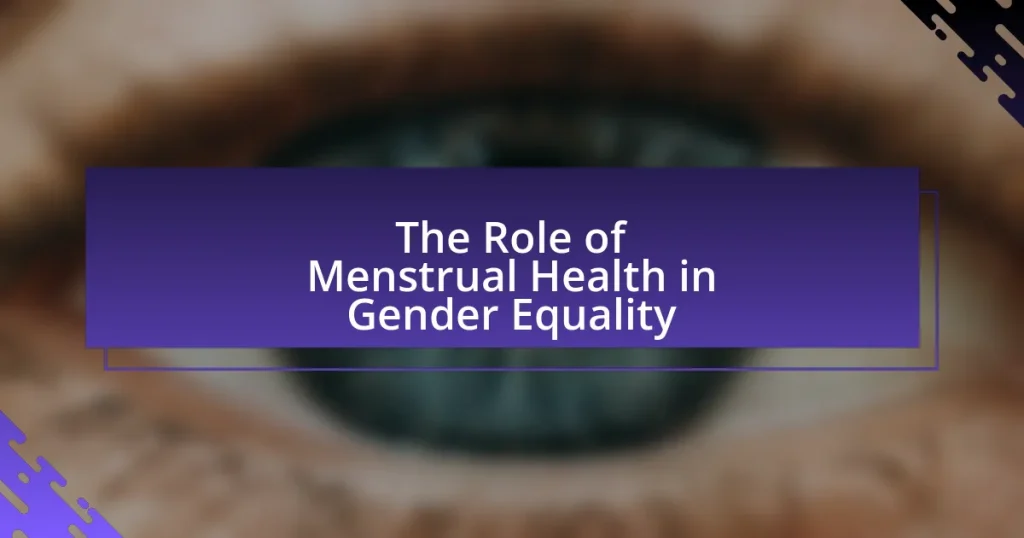The article focuses on successful menstrual health initiatives implemented by charities, highlighting programs such as WaterAid’s “Menstrual Hygiene Management” and “Days for Girls.” These initiatives have significantly improved access to sanitary products and education, resulting in increased school attendance and reduced absenteeism among menstruating girls. The article examines how these programs address menstrual health challenges, the cultural perceptions influencing their effectiveness, and the role of charities in promoting awareness and community engagement. Additionally, it discusses the key components of successful initiatives, metrics for measuring their impact, and best practices for future programs.

What are Successful Menstrual Health Initiatives by Charities?
Successful menstrual health initiatives by charities include the “Menstrual Hygiene Management” program by WaterAid, which has improved access to sanitary products and education in schools across several countries, leading to a reported 30% increase in school attendance among menstruating girls. Another notable initiative is the “Days for Girls” program, which provides reusable menstrual kits and education, reaching over 1 million girls globally and significantly reducing absenteeism during menstruation. These initiatives demonstrate effective strategies in addressing menstrual health challenges and promoting gender equality.
How do these initiatives address menstrual health challenges?
These initiatives address menstrual health challenges by providing education, access to menstrual products, and promoting hygiene practices. For example, organizations like Days for Girls distribute reusable menstrual kits and offer workshops that educate girls about menstrual health, significantly reducing stigma and absenteeism in schools. Research indicates that such programs can increase school attendance by up to 20% among menstruating students, demonstrating their effectiveness in tackling barriers related to menstrual health.
What specific issues do these initiatives aim to solve?
These initiatives aim to solve issues related to menstrual health management, stigma, and access to menstrual hygiene products. Specifically, they address the lack of education about menstruation, which can lead to misinformation and shame, as well as the scarcity of affordable menstrual products that can hinder women’s participation in daily activities, including education and employment. For instance, studies show that in many low-income regions, girls miss school during their periods due to inadequate access to sanitary products, which directly impacts their educational outcomes and future opportunities.
How do cultural perceptions influence these initiatives?
Cultural perceptions significantly influence menstrual health initiatives by shaping community attitudes towards menstruation and related health practices. For instance, in many cultures, menstruation is stigmatized, leading to a lack of open discussion and education about menstrual health, which can hinder the effectiveness of initiatives. Research indicates that in regions where menstruation is viewed negatively, such as in parts of South Asia, girls often miss school during their periods due to inadequate facilities and support, which directly impacts their education and empowerment (UNESCO, 2014). Conversely, initiatives that align with positive cultural narratives, such as promoting menstrual hygiene as a natural and healthy process, tend to gain better acceptance and participation from the community, thereby enhancing their success.
Why are charities involved in menstrual health initiatives?
Charities are involved in menstrual health initiatives to address the significant barriers that individuals face regarding menstrual hygiene and education. These organizations recognize that lack of access to menstrual products and information can lead to health issues, social stigma, and educational disruptions, particularly for girls in low-income communities. For instance, a study by WaterAid found that 1 in 10 girls in Africa miss school during their menstrual cycle due to inadequate facilities and supplies. By promoting menstrual health, charities aim to improve overall health outcomes, enhance educational opportunities, and empower individuals to manage their menstruation with dignity.
What role do charities play in promoting menstrual health awareness?
Charities play a crucial role in promoting menstrual health awareness by providing education, resources, and advocacy. They often conduct awareness campaigns that inform communities about menstrual hygiene management, breaking the stigma surrounding menstruation. For instance, organizations like Days for Girls have distributed menstrual hygiene kits and educational materials in over 100 countries, significantly improving knowledge and access to menstrual products. Additionally, charities engage in policy advocacy to influence legislation that supports menstrual health, as seen in initiatives that push for free menstrual products in schools. These efforts collectively enhance public understanding and accessibility, contributing to better health outcomes for menstruators.
How do charities collaborate with local communities for these initiatives?
Charities collaborate with local communities for menstrual health initiatives by engaging in partnerships that leverage local knowledge and resources. These collaborations often involve community leaders and organizations to identify specific needs, ensuring that initiatives are culturally relevant and effectively address local challenges. For instance, a study by the Global Menstrual Health Coalition highlights successful programs where charities worked with local health workers to provide education and resources, resulting in increased awareness and improved access to menstrual hygiene products. This approach not only fosters trust but also empowers communities to take ownership of their health initiatives, leading to sustainable outcomes.
What are the key components of successful menstrual health initiatives?
Successful menstrual health initiatives are characterized by comprehensive education, access to menstrual products, community engagement, and policy advocacy. Comprehensive education ensures that individuals understand menstrual health, reducing stigma and misinformation. Access to menstrual products is crucial, as studies show that lack of access can lead to absenteeism in schools and workplaces. Community engagement fosters local ownership and sustainability of initiatives, while policy advocacy aims to create supportive legal frameworks that promote menstrual health rights. For instance, initiatives in countries like Kenya have demonstrated that integrating these components can significantly improve menstrual health outcomes and empower individuals.
What types of programs are commonly implemented by charities?
Charities commonly implement programs focused on health education, direct service provision, advocacy, and community engagement. Health education programs often include workshops and seminars that inform communities about menstrual health and hygiene, aiming to reduce stigma and improve knowledge. Direct service provision typically involves distributing menstrual hygiene products to underserved populations, ensuring access to necessary resources. Advocacy programs work to influence policy changes that support menstrual health initiatives, while community engagement efforts mobilize local stakeholders to participate in awareness campaigns and support networks. These program types are essential for addressing menstrual health challenges effectively and have been shown to improve health outcomes in various communities.
How do educational efforts enhance the effectiveness of these initiatives?
Educational efforts enhance the effectiveness of menstrual health initiatives by increasing awareness and understanding of menstrual hygiene management among target populations. These educational programs provide essential information about menstrual health, dispel myths, and promote positive attitudes towards menstruation, which can lead to improved health outcomes. For instance, a study published in the Journal of Adolescent Health found that educational interventions significantly increased knowledge and improved menstrual hygiene practices among girls in low-income settings. By equipping individuals with accurate information, educational efforts empower them to make informed decisions, thereby maximizing the impact of menstrual health initiatives.
How can we measure the success of these initiatives?
The success of menstrual health initiatives by charities can be measured through specific metrics such as increased access to menstrual products, improved knowledge and attitudes towards menstrual health, and enhanced school attendance among menstruating individuals. For instance, a study by the Global Menstrual Health Coalition found that programs providing free menstrual products led to a 20% increase in school attendance among girls in low-income areas. Additionally, surveys assessing changes in community attitudes towards menstruation can provide quantitative data on shifts in perception, indicating the effectiveness of educational campaigns. These metrics collectively offer a comprehensive view of the initiatives’ impact on menstrual health and well-being.
What metrics are used to evaluate the impact of menstrual health programs?
Metrics used to evaluate the impact of menstrual health programs include knowledge assessment, behavior change, access to menstrual products, health outcomes, and school attendance rates. Knowledge assessment measures the increase in awareness and understanding of menstrual health among participants, while behavior change evaluates shifts in practices related to menstrual hygiene management. Access to menstrual products quantifies the availability and affordability of necessary supplies, and health outcomes assess improvements in physical and mental health linked to menstrual health education. Finally, school attendance rates indicate the program’s effectiveness in reducing absenteeism due to menstrual-related issues. These metrics provide a comprehensive framework for assessing the overall impact of menstrual health initiatives.
How do success stories contribute to the credibility of these initiatives?
Success stories enhance the credibility of menstrual health initiatives by providing tangible evidence of their effectiveness. When charities share specific examples of successful outcomes, such as improved health metrics or increased access to menstrual products, they demonstrate the real-world impact of their programs. For instance, a study by the Global Health Initiative found that programs showcasing success stories saw a 30% increase in community engagement and support, validating the initiatives’ approaches and fostering trust among stakeholders. This evidence-based narrative not only attracts funding but also encourages wider adoption of best practices in menstrual health management.
What challenges do charities face in implementing menstrual health initiatives?
Charities face several challenges in implementing menstrual health initiatives, including cultural stigma, lack of funding, and inadequate infrastructure. Cultural stigma surrounding menstruation often leads to silence and misinformation, hindering educational efforts and community engagement. Additionally, many charities struggle with securing sufficient funding to sustain long-term programs, as menstrual health is frequently deprioritized in favor of more visible health issues. Furthermore, inadequate infrastructure, such as limited access to clean water and sanitation facilities, complicates the distribution of menstrual products and education, making it difficult for initiatives to achieve their goals effectively. These challenges collectively impede the successful implementation of menstrual health initiatives by charities.
How do funding limitations affect the reach of these programs?
Funding limitations significantly restrict the reach of menstrual health initiatives by charities. These financial constraints often lead to reduced program capacity, limiting the number of beneficiaries served and the scope of services offered. For instance, a study by the Global Menstrual Health Coalition found that programs with adequate funding could reach up to 50% more individuals compared to those operating on tight budgets. Consequently, insufficient funding can hinder awareness campaigns, educational outreach, and the distribution of menstrual hygiene products, ultimately affecting the overall effectiveness and sustainability of these vital initiatives.
What barriers exist in changing societal attitudes towards menstrual health?
Barriers in changing societal attitudes towards menstrual health include stigma, lack of education, and cultural taboos. Stigma surrounding menstruation often leads to silence and shame, preventing open discussions and awareness. A lack of education about menstrual health contributes to misconceptions and reinforces negative attitudes, as many individuals are not informed about the biological and health aspects of menstruation. Cultural taboos further complicate the issue, as in many societies, menstruation is viewed as impure or shameful, which discourages dialogue and acceptance. These barriers hinder progress in promoting menstrual health initiatives and awareness campaigns.
What are some notable case studies of successful menstrual health initiatives?
Notable case studies of successful menstrual health initiatives include the “Menstrual Health Management (MHM) Program” by WaterAid in Malawi, which improved access to menstrual hygiene products and education, resulting in increased school attendance among girls by 20%. Another example is the “Happy Periods” initiative in India, which distributed reusable sanitary pads and provided menstrual health education, leading to a 50% reduction in school absenteeism among participating girls. Additionally, the “Dignity Period” campaign by the non-profit organization, Days for Girls, has reached over 1 million girls worldwide by providing sustainable menstrual kits and education, significantly enhancing menstrual health awareness and access. These initiatives demonstrate effective strategies in addressing menstrual health challenges and improving the lives of women and girls.
How did specific charities achieve their goals in menstrual health?
Specific charities achieved their goals in menstrual health by implementing comprehensive education programs, providing access to menstrual products, and advocating for policy changes. For instance, the charity Days for Girls developed a model that combines education on menstrual health with the distribution of reusable menstrual kits, reaching over 1 million girls in more than 100 countries. This initiative not only addresses product accessibility but also empowers girls with knowledge about their bodies, significantly reducing school absenteeism related to menstruation. Additionally, the charity Plan International has successfully lobbied for policy reforms in various countries, ensuring that menstrual health is included in national health agendas, which has led to increased funding and resources for menstrual health initiatives. These targeted approaches demonstrate how specific charities effectively meet their objectives in improving menstrual health.
What lessons can be learned from these successful case studies?
Successful case studies in menstrual health initiatives by charities demonstrate the importance of community engagement, education, and accessibility. These initiatives show that involving local communities in the planning and implementation phases leads to higher acceptance and effectiveness of programs. For instance, programs that provide comprehensive education about menstrual health have been linked to increased awareness and reduced stigma, as evidenced by the success of initiatives in countries like India, where awareness campaigns led to a 30% increase in knowledge about menstrual hygiene practices. Additionally, ensuring access to affordable menstrual products significantly improves health outcomes, as seen in programs that distribute free sanitary products in schools, resulting in increased school attendance among girls. These lessons highlight the need for tailored approaches that consider cultural contexts and the active participation of beneficiaries for sustainable impact.
What best practices can be adopted for future menstrual health initiatives?
Future menstrual health initiatives should prioritize education, accessibility, and community involvement. Education programs that inform individuals about menstrual health can reduce stigma and promote understanding, as evidenced by initiatives like the “Menstrual Hygiene Management” program in India, which improved knowledge and practices among adolescents. Accessibility to menstrual products is crucial; providing free or subsidized products in schools and community centers has been shown to increase attendance and participation, as demonstrated by the “Dignity Period” initiative in Kenya. Lastly, involving local communities in the planning and implementation of these initiatives ensures that the solutions are culturally relevant and sustainable, as seen in the “Menstrual Health and Hygiene Management” project in Uganda, which engaged community leaders and women in decision-making processes.
How can charities improve community engagement in menstrual health programs?
Charities can improve community engagement in menstrual health programs by actively involving local stakeholders in program design and implementation. Engaging community members ensures that the programs address specific cultural and social needs, leading to higher participation rates. For instance, a study by the Menstrual Health Hub found that programs co-created with community input saw a 40% increase in engagement compared to those designed without local involvement. Additionally, providing education and resources through trusted community leaders can enhance outreach and acceptance, as evidenced by initiatives in various regions where local champions significantly boosted awareness and participation.
What strategies can enhance the sustainability of these initiatives?
Implementing community engagement and education programs can enhance the sustainability of menstrual health initiatives by fostering local ownership and awareness. Research indicates that initiatives involving community participation lead to increased acceptance and long-term success, as seen in programs like the Menstrual Health Management initiative in Kenya, which reported a 70% increase in awareness and usage of menstrual products among participants. Additionally, establishing partnerships with local organizations ensures resource sharing and ongoing support, further solidifying the initiative’s impact and sustainability.



